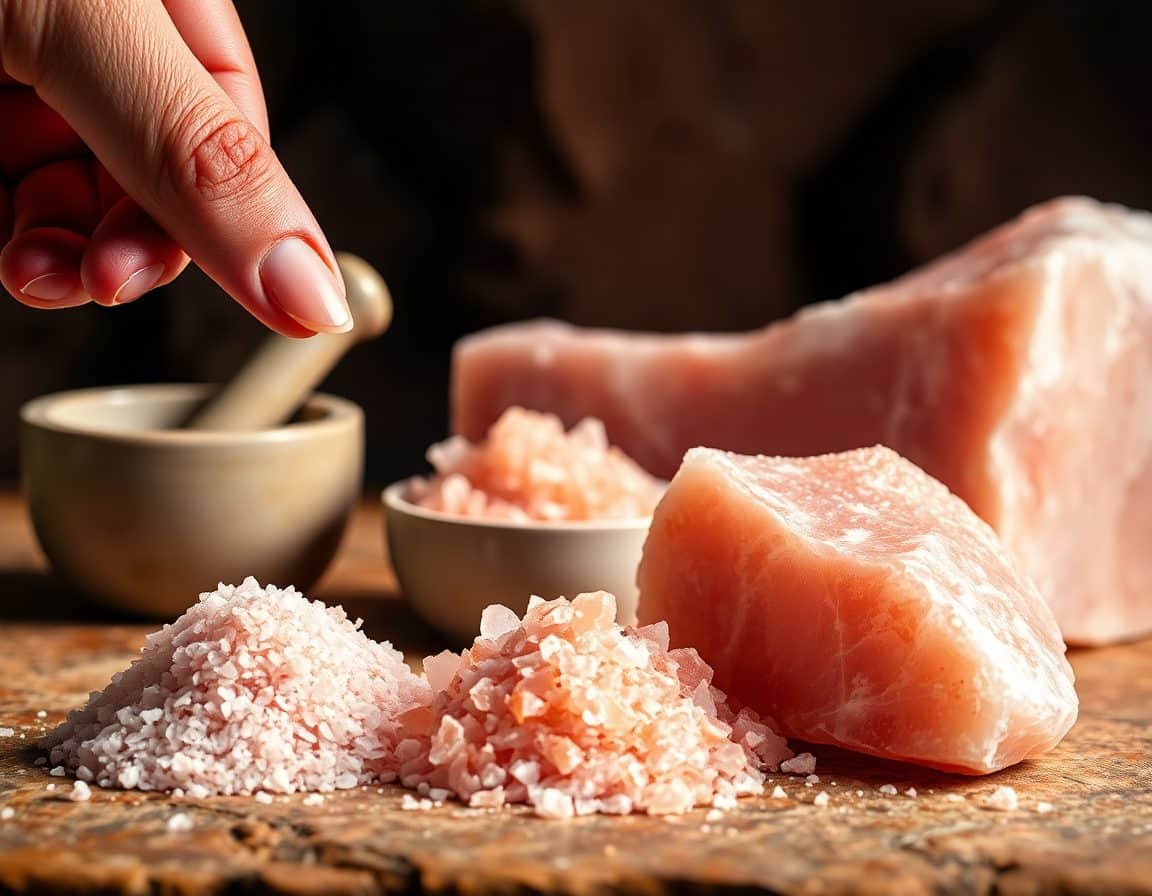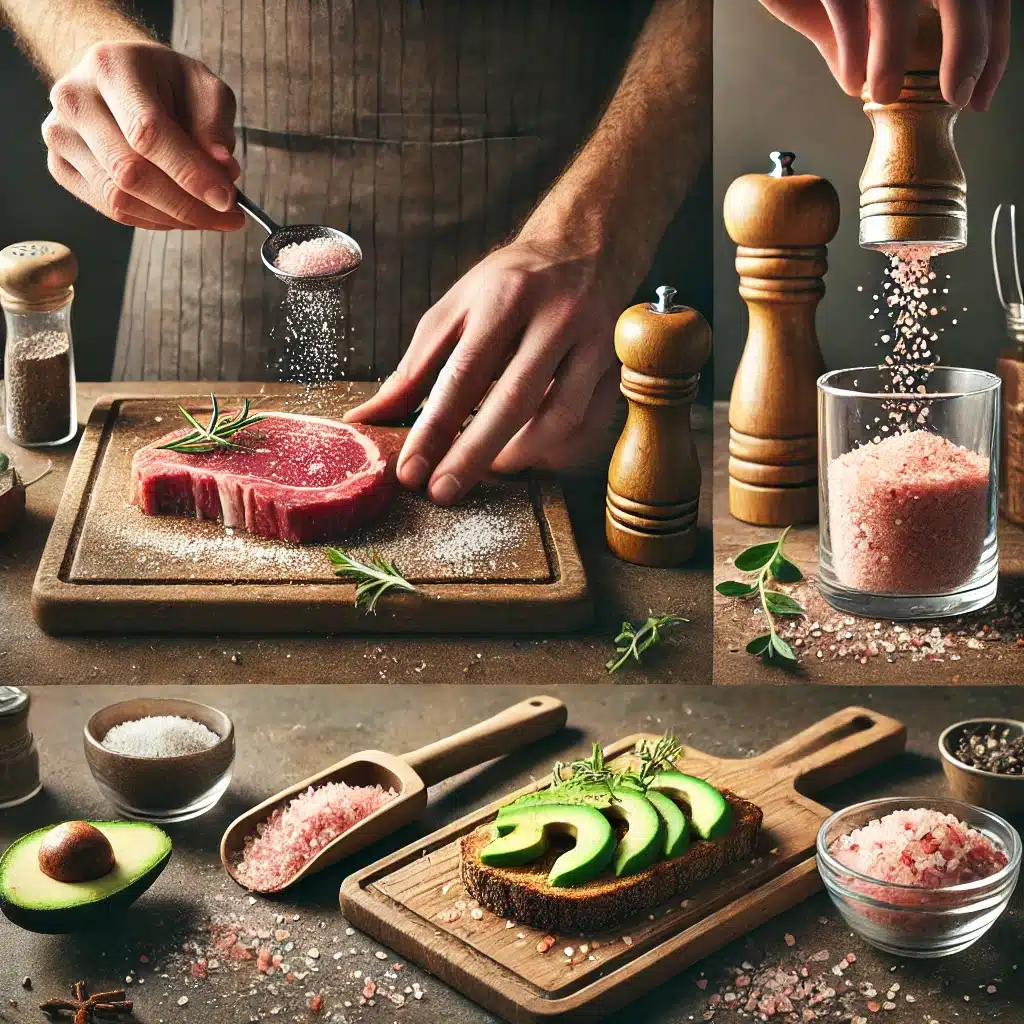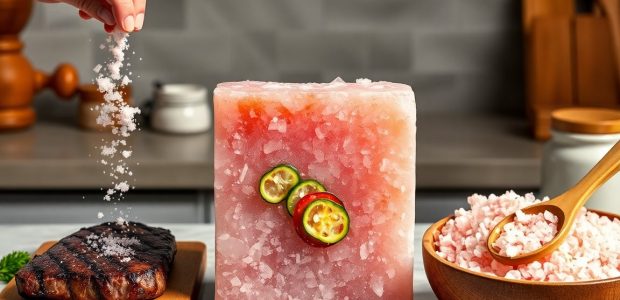Key Takeaways:
- Pink Himalayan salt has a milder flavor profile with subtle mineral notes compared to regular table salt, making it ideal for enhancing delicate dishes
- Use it in three primary ways: as an everyday seasoning (starting with about ¾ the amount of table salt), as a finishing salt for visual and textural impact, or in specialty applications like salt blocks and brining
- Different grain sizes serve different purposes: fine for baking and sauces, medium for general cooking, and coarse for finishing touches and visual appeal
- While not significantly healthier than regular salt, it’s free from additives and anti-caking agents found in conventional table salt
- For the best culinary results, invest in one of the Best Pink Himalayan Salts on the market and store properly in airtight containers away from moisture
Pink Himalayan salt has become a staple in upscale restaurants and home kitchens alike, not just for its Instagram-worthy pink hue but for its distinct culinary properties. Whether you’re new to this specialty salt or looking to elevate your current cooking techniques, this comprehensive guide will walk you through how to use Pink Himalayan salt in cooking to achieve maximum flavor and visual appeal in your dishes.
What Makes Pink Himalayan Salt Unique for Cooking
The journey to mastering Pink Himalayan salt in your culinary creations begins with understanding what sets this ingredient apart from the salt you may already have in your pantry.
Origin and Appearance
Mined from the ancient Khewra Salt Mine in Pakistan’s Punjab region near the Himalayas, this distinctive salt gets its rosy blush from trace amounts of iron oxide. Unlike processed table salt, Pink Himalayan salt crystals form naturally, resulting in a visually striking ingredient that can transform the presentation of any dish.
The salt’s extraction from one of the oldest and purest salt deposits on earth contributes to its growing popularity among chefs and food enthusiasts seeking authentic, minimally processed ingredients.
Flavor Profile and Mineral Content
While Pink Himalayan salt contains up to 84 trace minerals including potassium, magnesium, and calcium, it’s important to note that these make up only 1-2% of its composition. The remaining 98% is sodium chloride – the same compound found in regular table salt.
What truly distinguishes Pink Himalayan salt in cooking is its flavor profile:
- Milder taste compared to table salt, with less harsh saltiness
- Subtle mineral undertones that add complexity
- Clean finish without the slightly metallic aftertaste some detect in iodized salt
This gentle flavor makes it particularly suitable for delicate dishes where you want to enhance rather than overpower the natural taste of ingredients.
Differences from Regular Table Salt
Besides its color and taste, Pink Himalayan salt differs from regular table salt in several key ways:
- No additives: Unlike table salt, it contains no anti-caking agents or iodine supplements
- Texture variety: Available in various grain sizes from fine to extra coarse
- Lower sodium by volume: Due to its larger crystal size, coarse Pink Himalayan salt may contain less sodium per teaspoon than fine table salt
- Unrefined state: Minimal processing preserves its natural mineral content
Understanding these differences will help you make the right adjustments when substituting Pink Himalayan salt in your recipes.

Basic Ways to Use Pink Himalayan Salt in Cooking
Now that we understand what makes this salt special, let’s explore the fundamental techniques for incorporating it into your everyday cooking.
Everyday Seasoning Techniques
Pink Himalayan salt works beautifully as your go-to seasoning salt. Here’s how to use it effectively:
- Start with less: Because of its varying crystal size, begin with about ¾ of the amount of table salt called for in recipes, then adjust to taste
- Season throughout cooking: Add a pinch during different cooking stages to build depth of flavor
- Pre-season meats: Apply Pink Himalayan salt to meats 30-60 minutes before cooking to enhance juiciness and flavor
For optimal results when seasoning with Pink Himalayan salt, consider investing in a good salt grinder for coarse varieties. This allows you to adjust the grind size based on your specific cooking needs – from fine grinds for sauces to coarser grinds for meats.
Using as a Finishing Salt
One of the best ways to use Pink Himalayan salt in cooking is as a finishing salt – the final flourish that elevates a dish just before serving:
- Visual impact: The pink crystals create an appealing garnish on light-colored foods
- Textural contrast: Coarse grains provide a satisfying crunch against soft foods
- Flavor burst: Each crystal delivers a concentrated pop of flavor when biting into it
Ideal dishes for Pink Himalayan salt as a finishing touch include:
- Sliced avocado or tomatoes
- Fresh summer melons and stone fruits
- Caramel desserts or dark chocolate treats
- Grilled vegetables
- Poached eggs
A light sprinkle just before serving is all you need – this technique also helps you stretch your Pink Himalayan salt investment since you’ll use less than when cooking with it.
Substituting in Recipes
When replacing regular salt with Pink Himalayan salt in existing recipes, keep these tips in mind:
- Baking: Use finer grinds for even distribution in doughs and batters
- Soups and stews: Add gradually and taste often, as flavors develop differently
- Spice blends: Create signature seasoning mixes using Pink Himalayan salt as the base
For baking applications, many professionals recommend grinding coarse Pink Himalayan salt to a fine powder using a spice grinder or mortar and pestle to ensure it dissolves properly in your baked goods.

Creative Cooking Methods with Pink Himalayan Salt
Beyond basic seasoning, Pink Himalayan salt opens up unique cooking possibilities that can transform your culinary repertoire.
Cooking on Himalayan Salt Blocks
Himalayan salt blocks offer one of the most distinctive ways to use this salt in cooking. These solid slabs of Pink Himalayan salt serve as both cooking surface and seasoning agent:
- Preparation: Heat the block gradually (over about 30 minutes) to prevent cracking
- Cooking method: Once heated to approximately 500°F, use for grilling thin cuts of meat, seafood, or quick-cooking vegetables
- Flavor infusion: Food picks up subtle saltiness and mineral notes while cooking
- Presentation: Serve directly on the warm block for an impressive tableside display
Pro tip: After each use, allow your salt block to cool completely before cleaning with a damp cloth (never use soap, as the salt is naturally antibacterial).
Brining Meats and Seafood
Pink Himalayan salt makes an excellent base for brines that enhance moisture retention and flavor in meats and seafood:
Basic Pink Himalayan Salt Brine Recipe:
- ¼ cup Pink Himalayan salt
- 4 cups water
- Optional aromatics (garlic, peppercorns, bay leaves, citrus zest)
Dissolve the salt in the water, add any aromatics, then submerge your protein for the appropriate time:
- Chicken pieces: 2-4 hours
- Whole chicken: 8-12 hours
- Pork chops: 4-6 hours
- Seafood: 15-30 minutes
This technique is particularly effective before grilling or roasting meats that tend to dry out easily.
Adding to Beverages and Homemade Drinks
A surprising application of Pink Himalayan salt in cooking extends to beverages:
- Electrolyte drinks: Add a pinch to water with lemon juice and honey for a natural sports drink
- Coffee: A tiny amount (1/8 teaspoon) in coffee grounds can reduce bitterness
- Cocktails: Rim glasses with fine Pink Himalayan salt for margaritas or create salt-infused simple syrups
DIY Himalayan Salt Electrolyte Drink:
- 1 liter filtered water
- ¼ teaspoon Pink Himalayan salt
- 2 tablespoons fresh lemon juice
- 1 tablespoon honey or maple syrup
- Optional: sliced cucumber or berries
This makes a refreshing and natural alternative to commercial sports drinks.
Pro Tips for Maximizing Flavor with Pink Himalayan Salt
To truly master how to use Pink Himalayan salt in cooking, consider these professional insights that elevate your salt game.
Understanding Grain Size and Salt Intensity
The size of Pink Himalayan salt crystals directly impacts its saltiness per volume:
- Fine grain: More concentrated saltiness, dissolves quickly, good for baking
- Medium grain: Versatile all-purpose option for cooking
- Coarse grain: Less salt per teaspoon, excellent for finishing, provides textural interest
When working with coarse grains, remember that you may need to adjust quantities in recipes originally designed for fine table salt. For instance, you might need 1¼ teaspoons of coarse Pink Himalayan salt to equal the saltiness of 1 teaspoon of fine table salt.
Pairing with Different Food Types
Pink Himalayan salt shines when paired strategically with different food categories:
- Delicate flavors: Use with light fish, simple pasta dishes, or steamed vegetables where its subtle mineral notes enhance without overwhelming
- Sweet contrasts: Pair with caramel, chocolate, or fresh fruits to create intriguing sweet-savory combinations
- Fatty foods: The clean taste cuts through richness in avocados, butter, or olive oil
For an unforgettable taste experience, try sprinkling a few crystals of coarse Pink Himalayan salt on high-quality dark chocolate or fresh watermelon – the contrast creates a flavor explosion that highlights both ingredients.
Storage and Maintenance
To preserve the quality of your Pink Himalayan salt:
- Store in airtight containers away from moisture and humidity
- Keep salt blocks dry between uses to prevent dissolution
- Consider stylish salt cellars for easy access while cooking (they make great countertop accessories too)
Pink Himalayan salt has an indefinite shelf life when stored properly, making it a worthwhile investment for your kitchen. For those looking to start cooking with this ingredient, exploring reviews of the best pink Himalayan salts available can help you choose a high-quality product that will enhance your culinary creations.

Delicious Recipes Featuring Pink Himalayan Salt
Put your newfound knowledge into practice with these tested recipes that showcase Pink Himalayan salt’s versatility.
Savory Dishes Enhanced by Pink Himalayan Salt
Garlic Butter Steak with Pink Himalayan Salt
This simple yet elegant preparation lets Pink Himalayan salt shine in multiple roles – as a seasoning, cooking medium, and finishing touch.
Ingredients:
- 2 ribeye or NY strip steaks (1-inch thick)
- 2 tablespoons unsalted butter
- 2 cloves garlic, finely minced
- 1 tablespoon soy sauce
- Pink Himalayan salt
- Freshly ground black pepper
Instructions:
- Season steaks generously with Pink Himalayan salt and black pepper
- Heat a cast-iron skillet over high heat
- Add 1 tablespoon butter to the pan, then sear steaks 4-5 minutes per side for medium-rare
- While steaks cook, mix remaining butter with garlic, soy sauce, and a pinch of Pink Himalayan salt
- Let steaks rest 5 minutes, then top with garlic butter mixture
- Finish with a sprinkle of coarse Pink Himalayan salt before serving
Cucumber Salad with Red Onion and Pink Himalayan Salt
This refreshing side dish demonstrates how Pink Himalayan salt can enhance even the simplest preparations.
Ingredients:
- 2 English cucumbers, thinly sliced
- 1 small red onion, thinly sliced
- 1 tablespoon Pink Himalayan salt (plus more for finishing)
- 2 tablespoons white wine vinegar
- 1 tablespoon extra virgin olive oil
- Fresh dill (optional)
Instructions:
- Place cucumber and onion slices in a colander, sprinkle with 1 tablespoon Pink Himalayan salt, and let sit 15 minutes
- Rinse lightly and pat dry
- Toss with vinegar, olive oil, and dill if using
- Chill for 30 minutes
- Just before serving, finish with a light sprinkle of fine Pink Himalayan salt
Sweet and Salty Combinations to Try
Salted Caramel Cookies with Pink Himalayan Salt
The perfect showcase for the visual appeal and flavor-enhancing properties of Pink Himalayan salt in sweet applications.
Ingredients:
- Your favorite chocolate chip cookie dough
- ½ cup caramel bits or soft caramel candies
- Coarse Pink Himalayan salt for topping
Instructions:
- Prepare cookie dough according to recipe
- Fold in caramel bits
- Shape into cookies and bake as directed
- While still warm from the oven, sprinkle each cookie with a few crystals of coarse Pink Himalayan salt
- Allow to cool completely before serving
FAQ: Common Questions About Cooking with Pink Himalayan Salt
Conclusion: Elevate Your Cooking with Pink Himalayan Salt
Learning how to use Pink Himalayan salt in cooking opens up a world of culinary possibilities that go far beyond simple seasoning. From its visually striking appearance to its nuanced flavor profile, this unique ingredient deserves a place in every serious cook’s arsenal.
Whether you’re seasoning a steak, finishing a salad, baking cookies, grilling on a salt block, brining chicken, or mixing up a refreshing beverage, Pink Himalayan salt adds both flavor and visual appeal that can transform everyday dishes into memorable culinary experiences.
Remember that while Pink Himalayan salt does contain trace minerals, its primary value lies in its culinary properties rather than significant health benefits. Use it thoughtfully to enhance your cooking while maintaining a balanced approach to sodium intake.
Ready to experience the difference? Start with one of the recipes shared in this guide, or simply try substituting Pink Himalayan salt in your favorite dish. For optimal results, make sure you’re using one of the best pink Himalayan Salts on the market, as quality can significantly impact flavor. The subtle yet distinct improvement in taste might just make you a Pink Himalayan salt enthusiast for life.

